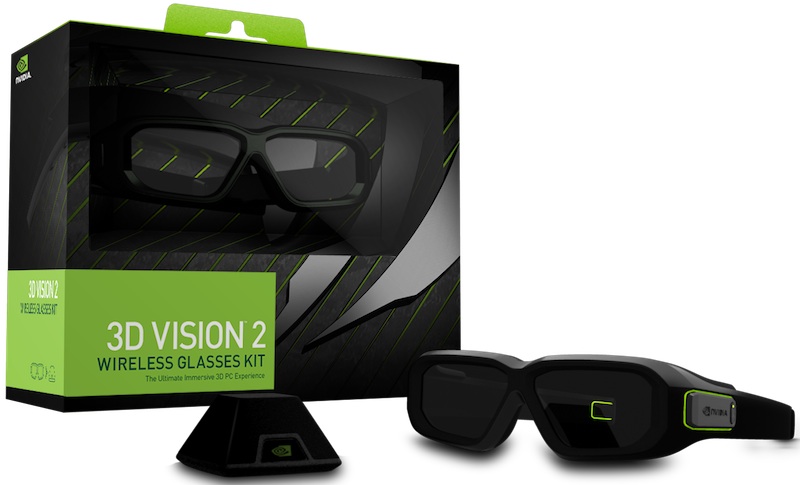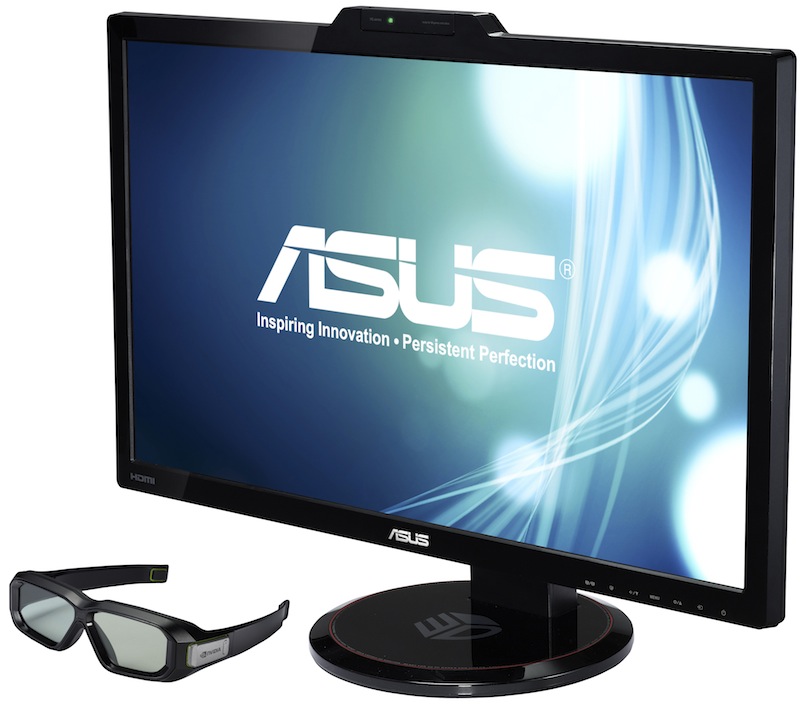 NVIDIA Corporation announced its new 3D Vision 2 active-shutter glasses and 3D LightBoost display technology.
NVIDIA Corporation announced its new 3D Vision 2 active-shutter glasses and 3D LightBoost display technology.
For more information visit: www.nvidia.com
Unedited press release follows:
 NVIDIA 3D Vision Vaults to New Dimension With Next-Gen 3D Glasses and Monitors
NVIDIA 3D Vision Vaults to New Dimension With Next-Gen 3D Glasses and Monitors
New 3D Vision 2 Glasses, Brighter 3D LightBoost Monitor Technology Immerse Gamers Into Vivid 3D Worlds
SANTA CLARA, CA–(Oct 14, 2011) – The best 3D technology for the PC just got better with the introduction of new NVIDIA®3D Vision™ products, which deliver greater realism and immersion than ever for 3D games, movies and photos.
NVIDIA 3D Vision 2, the next generation of NVIDIA’s award-winning 3D technology, features sleek, newly-redesigned, gamer-inspired glasses. It also introduces NVIDIA 3D LightBoost™ technology, a unique new display technology that dramatically improves the 3D experience by delivering images that are up to twice as bright and colors that are far richer than those provided by other 3D display technologies.
These features give gamers the ultimate 3D platform for this fall’s hot new titles, including Batman: Arkham City, LA Noire and more. In addition, through the NVIDIA 3D Vision Ready ecosystem, NVIDIA is delivering the industry’s broadest selection of high-quality 3D content and supported displays.
“Gorgeous, bright, crystal-clear 3D worlds are created by NVIDIA’s 3D Vision 2 glasses with 3D LightBoost monitors and notebooks,” said Phil Eisler, general manager of 3D Vision at NVIDIA. “NVIDIA’s engineering team has made incredible enhancements in 3D on PCs, creating a breathtaking gaming experience that’s better than the best Hollywood 3D movie.”
“NVIDIA 3D LightBoost technology makes 3D games, movies and photos more stunning and life-like than ever before,” said David Wung, senior director of product management of Open Platform Business (OPBG) Group for ASUS Computer International. “With 3D LightBoost and our new full-HD monitors, colors are richer, textures and subtle image details virtually jump off the screen, and the overall quality of the experience is something to behold. We are thrilled to be the first desktop display manufacturer to bring this new level of 3D visual quality to our customers with the ASUS VG278H.”
NVIDIA 3D Vision 2 Glasses
NVIDIA 3D Vision 2 glasses were designed specifically for gamers and 3D enthusiasts. They provide deeper immersion in games through lenses that are 20 percent larger than those in first-generation glasses, resulting in a wider viewing area and increased external light blocking. In addition, NVIDIA 3D Vision 2 glasses are made of soft composite materials for a more comfortable fit with gaming headphones.
The glasses, which feature NVIDIA’s advanced active-shutter and IR wireless technologies, allow gamers and 3D enthusiasts to access the broadest selection of high-quality 3D content available today, including more than 550 full-HD 1080p 3D games, more than 100 Blu-ray 3D movies and thousands of 3D videos and photos from YouTube and 3DVisionLive.com. In addition, NVIDIA 3D Vision 2 glasses are fully backwards-compatible with all existing NVIDIA 3D Vision Ready content and supporting products, including more than 70 different 3D Vision monitors, notebooks and projectors, video applications, and cameras.
NVIDIA 3D LightBoost Technology
NVIDIA 3D LightBoost is a new NVIDIA display technology that delivers up to 2X brighter 3D images than existing 3D solutions and improved color quality. It also dramatically increases environmental lighting, making gaming keyboards and mice more visible, and reducing 3D ghosting.
The first NVIDIA 3D LightBoost-certified desktop display is the ASUS VG278H, a 27-inch LED full HD (1920×1080) monitor, featuring a 3D HDMI 1.4 input, as well as a Dual-link DVI input for full HD 1080p 3D gaming. ASUS’ exclusive Trace-Free II Technology features 120Hz refresh rates and 2ms response times, resulting in vivid, ultra-smooth visuals. Expected to be available by the end of October 2011, the ASUS VG278H includes NVIDIA 3D Vision 2 glasses and is priced at $699 (USD MSRP).
Additional NVIDIA 3D LightBoost-compatible displays from Acer and BenQ are expected to ship in the coming months. NVIDIA 3D LightBoost compatible notebooks include several Toshiba models — Satellite P770/P775, Dynabook Satellite T572, Dynabook T572, and the Qosmio X770/X775 — with others expected in the coming months.
3D Vision 2 Pricing and Availability
The 3D Vision 2 glasses kit, which includes one pair of NVIDIA 3D Vision 2 glasses and a wireless USB IR emitter, will be available from the leading retailers/e-tailers worldwide in October for $149 (USD MSRP). It will also be available on the NVIDIA online store. Extra NVIDIA 3D Vision 2 glasses are available for $99 (USD MSRP). Visit www.nvidia.com/3dvision for more information.
About NVIDIA 3D Vision
NVIDIA is the worldwide leader in 3D technology for personal computers. NVIDIA 3D Vision and 3D Vision 2 technology, which includes 3D Vision software and advanced active shutter glasses, delivers breathtaking stereoscopic 3D images for gamers, movie-lovers and photo enthusiasts when configured with NVIDIA GPUs and a 3D display or projector. NVIDIA 3D Vision technology supports the richest array of 3D content available, including more than 550 3D games, Blu-ray 3D movies, 3D photos and streaming Web video. It also enables users to upload, share and view full-resolution 3D photos, as well as enjoy 3D movies at NVIDIA 3DVisionLive.com, the world’s first 3D Vision online community. In addition, NVIDIA 3DTV Play™ software enables consumers to attach their PC or notebook to 3D HDTVs and HDMI 1.4-capable audio/video receivers and enjoy all the latest 3D content in the comfort of their living rooms in full HD 3D, and with HD surround sound audio.
NVIDIA 3D Vision Pro™ technology is a combination of wireless active shutter glasses and advanced software, which automatically transform business-oriented applications into full stereoscopic 3D to improve the usefulness of the applications and increase productivity. 3D Vision Pro technology is designed for multi-user, collaborative viewing and production environments, and features long-range, bi-directional 2.4GHz radio communication.
About NVIDIA
NVIDIA (NASDAQ: NVDA) awakened the world to computer graphics when it invented the GPU in 1999. Today, its processors power a broad range of products from smart phones to supercomputers. NVIDIA’s mobile processors are used in phones, tablets and auto infotainment systems. PC gamers rely on GPUs to enjoy spectacularly immersive worlds. Professionals use them to create visual effects in movies and design everything from golf clubs to jumbo jets. And researchers utilize GPUs to advance the frontiers of science with high-performance computers. The company holds more than 2,100 patents worldwide, including ones covering ideas essential to modern computing. For more information, see www.nvidia.com.

